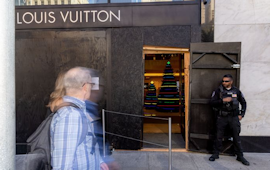|
Snapchat and Other Apps Were Used to Plan Flash-Mob Thefts, Police Say
Suspects in recent crimes at Nordstrom, Best Buy
and Louis Vuitton stores often don’t know each other, making investigations
difficult
 SAN
FRANCISCO—A
recent rash of thefts by fast-moving mobs at stores in the Bay Area and
outside Minneapolis were organized on social media and committed by people who
often didn’t know one another, according to law-enforcement officials
investigating the incidents. SAN
FRANCISCO—A
recent rash of thefts by fast-moving mobs at stores in the Bay Area and
outside Minneapolis were organized on social media and committed by people who
often didn’t know one another, according to law-enforcement officials
investigating the incidents.
Snapchat was among the social-media apps and messaging services used by thieves
in the Bay Area, one of the law-enforcement officials said.
The organizing tactics, which police say they haven’t seen before, make it
difficult to catch or identify perpetrators, that official said. When suspects
are arrested, they often don’t have names or information about others who were
there.
“This isn’t ‘The
Godfather’ by any stretch,” said Steve Wagstaffe, the San Mateo County,
California, district attorney who is part of a newly formed alliance of Bay Area
prosecutors tackling
organized retail theft. “It’s the modern version of ‘Hey,
there’s a party tonight’ and suddenly you have 100 kids showing up.”
Three of the estimated 90 people who overran a Nordstrom Inc. store in the
wealthy Bay Area suburb of Walnut Creek, Calif., on Nov. 20 have been arrested,
according to Walnut Creek police. The thieves stole more than $100,000 of
merchandise in one minute before escaping in 25 separate cars that had their
license plates removed or covered, prosecutors said.
&uuid=(email))
In San Francisco, five people were arrested in connection with the Nov. 19
smash-and-grab burglary by 20 to 40 people at a Louis Vuitton store, according
to San Francisco prosecutors.
Police in the Minneapolis suburbs, where a large group of thieves hit three
separate Best Buy Co. stores on Nov. 26, have identified some suspects but made
no arrests, said Lt. Joe Steiner of the Maplewood Police Department.
Similar crimes also occurred at stores in Los Angeles, Chicago and other parts
of the Bay Area. Los Angeles police, who have made several arrests, declined to
comment on how the thefts were organized.
In response to these incidents,
police have stepped up patrols
in retail corridors across the U.S.
Retailers in San Francisco’s Union Square, a shopping and tourist destination,
have boarded up their glass windows.
Property crimes including theft are starting to rise in some major cities such
as San Francisco and Los Angeles after falling during the first year of the
Covid-19 pandemic. In San Francisco, property crime is up 10% this year through
the first week of December from the same period last year, but down 15% from
2019.
Bay Area law-enforcement officials say they first saw the unusual phenomenon of
mass thefts and robberies last year during protests over the murder of George
Floyd by a Minneapolis police officer. In one example, more than 70 new cars
were stolen from a Dodge dealership in San Leandro, Calif., on the night of May
31, 2020.
Similar crimes occurred on Nov. 3, 2020, the night of the presidential election,
when several marijuana businesses were overrun by large groups of armed robbers
in Oakland.
The officials said they don’t know whether those incidents were organized on
social media.
Police agencies around the Bay Area banded together, and promised to share
information on such crimes after the election-night robberies. Under the new
information-sharing arrangement, Walnut Creek police received an alert on the
evening of Nov. 20, 2021, about the potential for an organized retail theft in
the area, local police officials said at a city-council meeting last week. There
were no details about the location or the target. Within minutes, the Nordstrom
had been overrun.
wsj.com
|